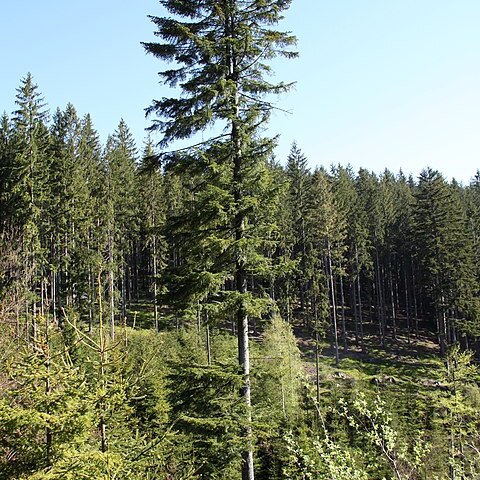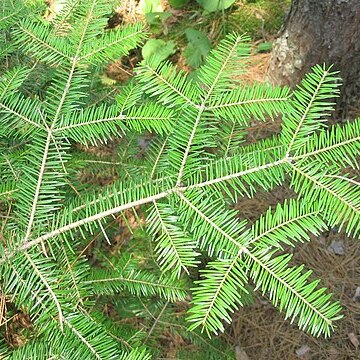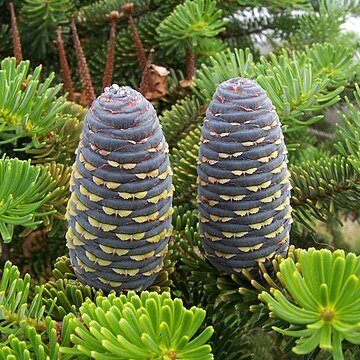Trees evergreen; branches regularly whorled; branchlets opposite (rarely whorled), with orbicular, depressed leaf scars and persistent bud scales at base; short branchlets absent; winter buds usually 3 at apex of branchlets, subglobose, ovoid, or conical, often resinous. Leaves spirally arranged, radially spreading, or pectinately arranged in lateral sets, linear, straight or curved, flattened, grooved adaxially, stomatal bands 2, abaxial, vascular bundle 1, resin canals 2(-10 outside China), marginal (in hypodermis) or median (in mesophyll), rarely submedian, base twisted. Pollen cones borne in leaf axils of previous year’s branchlets, pendulous, narrowly ellipsoid or oblong when young, finally cylindric; pollen 2-saccate. Seed cones pedunculate or sessile, erect, ovoid-cylindric or shortly cylindric, maturing in 1st year. Seed scales closely overlapping, often reniform, trapeziform, or flabellate, woody, base narrowed, deciduous at maturity. Bracts oblong, obcordate, or obovate, with exserted or included, sometimes reflexed cusp. Seeds borne in a membranous cup, obliquely ovoid or cuneate-oblong; wing well developed, persistent, cuneate-dolabriform or oblong-cuneate. Cotyledons (3 or)4-8(-12). Germination epigeal. 2n = 24*.
Evergreen, resinous, conic or pyramidal trees, usually with smooth bark and whorled branches. Short shoots 0. Buds very variable in shape, generally resinous. Lvs solitary, spirally arranged, linear or linear-oblong, usually ± 2-ranked and often arranged pectinately (except on young erect shoots), leaving a flat circular scar (hence older shoots ± smooth), flattened, generally dark green above and with broad white to glaucous-grey stomatal bands below, less often both sides stomatiferous and glaucous-grey; resin ducts 2, marginal (just below surface) or median. ♂ strobili (cones) situated in upper lf axils on underside of shoots, catkin-like, yellow to red. ♀ cones terminal, erect, usually purple, ripening in first year; ovuliferous scales rather thin; ovules 2 to each scale. Mature cone often dark purple, with bract scales included or exserted, disintegrating; axis persistent. Seed with large wing.
Male cones ovoid or short-cylindric, pendulous on short stalks from the axils of lvs of the preceding year, subtended by conspicuous bud-scales; female cones erect, cylindric, typically confined to the upper part of the tree, the scales individually deciduous at maturity, so that the cone rarely falls intact; bracts longer than the ovuliferous scales at anthesis, but often surpassed and hidden at maturity; evergreen trees, the lvs attached directly to the twigs and leaving a smooth, round scar on falling; 2n=24. 40, N. Temp.



